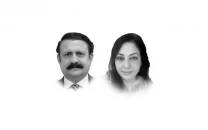Unsilencing abuse against women
Neither education nor wealth imply a greater likelihood that women will seek help against violence in India

The writer is the editor and translator of Why I write: Essays by Saadat Hasan Manto, published by Westland in 2014. His book, India, Low Trust Society, will be published by Random House. He is Executive Director of Amnesty International India. The views expressed here are his own
aakar.patel@tribune.com.pk
The azadi slogans of the students have always included freedom from patriarchy and this is something unusual and to be supported by all of us.
It is a fine thing to be a middle-class male in India because even in one of the poorest parts of the world, one is privileged. The Indian woman, no matter what class and what caste she comes from, must suffer prejudice under a culture shot through with patriarchy. Sexual violence against women is not something unique to India, but it is true that in our parts, the victim must also contend with other burdens. Such as the notion of ‘honour’ and its loss.
News on any given day will have the most horrific stories in which women are victimised even after crimes against them. This morning, as I write this, comes news of a 13-year-old girl who was whipped in public by a caste panchayat because her father abused her. Is it surprising that women distrust the state and society when it comes to sexual violence? Some of the data on this will interest readers.
The government conducts the National Family Health Survey in households to feed the Ministry of Health and Family Welfare on maternal and child health, to inform policies. It also talks about the incidence of violence. This becomes complicated also because in India, sexual violence by husbands, i.e., marital rape, is not criminalised — so it doesn’t get counted in this.
Here are the findings from the Indian government’s survey, with a sample of 83,703 women, aged 15-49 only one out of one hundred women who face sexual violence report it to the police; 5.7 per cent of men forcefully assault their wives when they refuse sexual intercourse with them, 19.8 per cent “get angry and reprimand her”, six per cent refuse her financial support, 4.2 have have sex with another woman. The data also suggest that 44 per cent of women with no education have experienced violence at some time since the age of 15, and 26 per cent have experienced violence in the past 12 months. These proportions decline steadily with education, and the corresponding proportions for women who have completed 12 or more years of education are 14 per cent and six percent, respectively. Two out of three women who have ever experienced violence have not only never sought help, but have also never told anyone about the violence. A large majority of women who have experienced only sexual violence have never told anyone about it (85 per cent), and only eight per cent have ever sought help. By contrast, 37 per cent of women who have experienced both physical and sexual violence and 22 per cent who have experienced only physical violence have sought help. Help seeking varies by the type of perpetrator. Women who have experienced violence by a former husband are the most likely to have sought help. This is to be expected since seeking help against spousal violence is likely to be a first step in being able to leave an abusive husband and ending the marriage.
Overall, the data suggests that neither education nor wealth imply a greater likelihood that women will seek help against violence. There is even some indication that the most educated women and women in the highest wealth quintile are less likely to seek help than less educated or less wealthy women. Abused women most often seek help from their own families. About 72 per cent of women who experienced only physical violence and 58 per cent of women who experienced only sexual violence, mention their own family as a source.
Women in urban areas who experience sexual violence are more likely, and those who experience physical violence are less likely, than their rural counterparts to report each of the different sets of injuries. Few women seek help from any institutional sources such as the police, medical personnel, or social service organisations.
Published in The Express Tribune, March 6th, 2016.
Like Opinion & Editorial on Facebook, follow @ETOpEd on Twitter to receive all updates on all our daily pieces.
















COMMENTS
Comments are moderated and generally will be posted if they are on-topic and not abusive.
For more information, please see our Comments FAQ